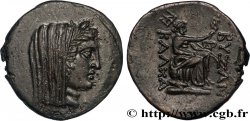bgr_353389 - THRACIA - BYZANTION Tétradrachme
недоступный.
Товар уже продан в нашем интернет-магазине (2015)
Цена: : 2 800.00 €
Товар уже продан в нашем интернет-магазине (2015)
Цена: : 2 800.00 €
Тип Tétradrachme
Дата: c. 220-219 AC.
Монетный двор / Город: Byzance, Thrace
Металл: silver
Диаметр: 27,5 mm
Ориентация осей монеты: 12 h.
Вес: 13,77 g.
Редкость: R3
Комментарии о состоянии
Exemplaire sur un flan ovale, bien centré des deux côtés avec une petit manque de métal à 9 heures au droit. Belle tête de Déméter au droit. Revers finement détaillé, de frappe un peu molle. Patine grise superficielle avec des reflets dorés avec un argent légèrement corné
Ссылки в каталоге: :
Происхождение:
Cet exemplaire provient de la vente CNG, 75, n° 100 et de la collection B. Odaert
Лицевая сторона
Аверс: легенда: ANÉPIGRAPHE.
Аверс: описание: Tête voilée de Déméter à droite, coiffée d’une couronne d’épis.
Обратная сторона
Реверс: Описание: Poséidon nu jusqu’à la ceinture assis à droite sur un rocher, tenant un aplustre de la main droite tendue et un trident transversal de la main gauche.
Реверс: легенда: EPI AQENAIWN/ (KK) - (UP).
Реверс: перевод: (du magistrat Athénaion/ Byzance).
Комментарий
Semble de mêmes coins que l’exemplaire de la vente Hirsch 275, n° 3381.








 Cообщить об ошибке
Cообщить об ошибке Распечатать страницу
Распечатать страницу Отправить мой выбор
Отправить мой выбор Задать вопрос
Задать вопрос Consign / sell
Consign / sell
 Информация
Информация